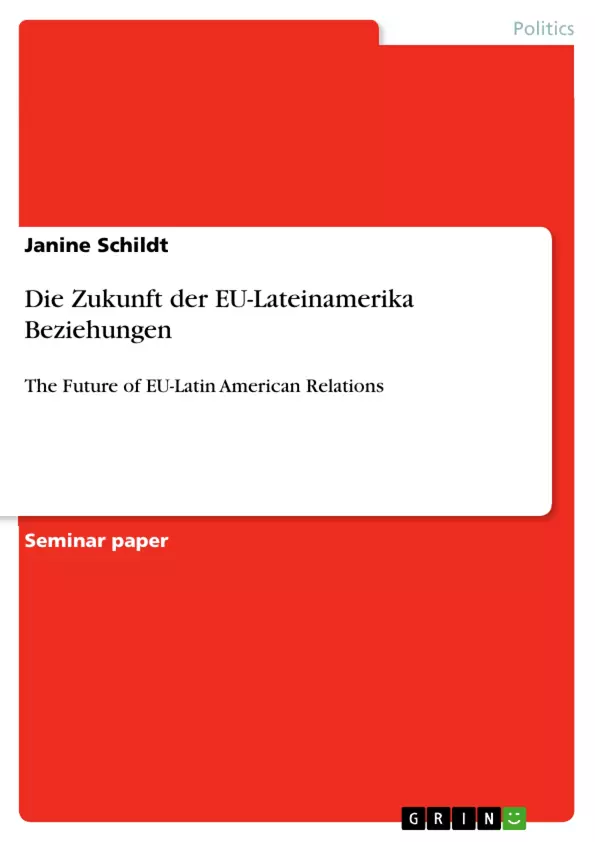1. Introduction
“Latin America is absent from the European agenda, except when a summit between the two regions comes around and Europe cannot show up empty‐handed.” This statement from the Spanish Elcano Royal Institute can be underlined by trade figures. 2008 only one Latin American country (Brazil) was among the 20 most important EU trading partners. The EU’s economic relations with countries like Vietnam, Kazakhstan or Angola are more substantial than with Venezuela, Colombia or Peru.
While economic importance of Latin America and the Caribbean (LAC) for the EU is small and even declining , relations are far more vital for the other side. In 2007, the EU was the second largest trading partner for the region and provided most foreign direct investments and official development assistance. Nonetheless, with only 4% of EU development aid, the region receives least in global comparison. From a LAC viewpoint, the relations have fallen short of expectations considering the strong historic and cultural ties and the hope created by the launch of a new strategy in the mid-90s promising greater access to the European market. Since 1999 five EU-LAC summits have been held declaring an interregional approach and the vision of a Bi‐regional Strategic Partnership but no significant progress has been achieved. In May 2010 another summit will take place, this time under Spanish Presidency, and skepticism exists whether great advancement can be reached.
The paper will outline today’s EU-LAC relations and give an outlook for the future. A changed global scenario requires a new approach towards LAC which needs to consider the shortcomings in internal integration as well as the differences in development within the region. A pure focus on bilateral agreements will not be a sustainable solution. Moreover, trade centered negotiations with LAC countries do not acknowledge the growing political influence of the region. Thus, political dialogue and social issues should play a stronger role in interregional relations.
Inhaltsverzeichnis (Table of Contents)
- Introduction
- EU-LAC Relations Today
- A changed world scenario
- A new strategy for EU-Latin American Relations
Zielsetzung und Themenschwerpunkte (Objectives and Key Themes)
The paper examines the current state of EU-Latin American relations and explores potential future directions. It analyzes the evolution of these relations since the 1990s, considering the changing global context and the diverse challenges facing both regions.
- The declining economic importance of Latin America for the EU.
- The impact of internal integration challenges within Latin America on EU-LAC relations.
- The limitations of a bilateral approach to EU-LAC relations.
- The need for greater political dialogue and social engagement in interregional relations.
- The evolving role of Latin America as a global player.
Zusammenfassung der Kapitel (Chapter Summaries)
- Introduction: The introduction highlights the lack of attention given to Latin America on the European agenda, despite the region's historical and cultural significance. It emphasizes the disparity between the EU's limited economic interest in the region and the significant importance Latin America places on relations with the EU.
- EU-LAC Relations Today: This chapter presents a comprehensive overview of the current state of EU-LAC relations. It analyzes the EU's interregional approach, focusing on the varying degrees of progress made in negotiations with different sub-regional organizations like MERCOSUR, CAN, Central America, and CARICOM. The chapter also explores the challenges posed by the signing of bilateral agreements with individual Latin American countries and the growing influence of populist left-wing governments in the region.
- A changed world scenario: This chapter examines the changing global context and its impact on EU-LAC relations. It analyzes the evolution of many Latin American countries into middle-income countries, their increasing economic presence on the global stage, and the declining interest of the EU in the region. The chapter also highlights the rise of new global actors, such as China and India, who are filling the void left by the EU and the US in Latin America.
Schlüsselwörter (Keywords)
Key terms and concepts include EU-Latin American relations, regional integration, bilateral agreements, political dialogue, social issues, trade, development aid, global players, emerging economies, multilateral setting, interregional cooperation, subregional organizations, and strategic partnerships.
- Arbeit zitieren
- Janine Schildt (Autor:in), 2009, Die Zukunft der EU-Lateinamerika Beziehungen, München, GRIN Verlag, https://www.grin.com/document/159971



